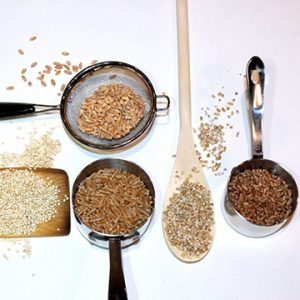All About Whole Grains
May 1, 2019
Studies consistently show that a diet rich in whole grains is linked to a lower risk of heart disease, stroke, type 2 diabetes, certain cancers, and obesity. Whole grains are also good for your digestive system. They promote regularity and their fiber and resistant starch provide fuel for the beneficial bacteria in your large intestine. The benefits of fueling the bacteria in your gut will help boost your immune system and decrease inflammation. Overall, studies show that consuming two to three servings of whole grain foods per day will provide health benefits.
What is a whole grain?
A whole grain contains all 3 parts of the kernel: the bran, the germ, and the endosperm.
The bran is the outer layer that is rich in fiber and supplies B vitamins, iron, copper, zinc, magnesium, antioxidants, and phytochemicals. Phytochemicals are natural chemical compounds in plants that have benefits in disease prevention.
The germ is the core of the seed. It is rich in healthy fats, vitamin E, B vitamins, phytochemicals, and antioxidants.
The endosperm is the interior layer that holds carbohydrates, protein, and small amounts of some B vitamins and minerals.
The nutrients in whole grains may have individual, collaborative, or additive actions that positively affect health. Examples of whole grains are oats, brown rice , kamut, quinoa, spelt, farro, and freekah.
What is a refined grain?
A refined or processed grain contains mostly just the endosperm and has had some or all of the bran and germ removed. The results of removing parts of the kernel as in refined grains is a loss of fiber, vitamins, minerals, and antioxidants. When the grain is refined, about 66% of the iron and 41% of the folic acid are lost, along with large percentages of other key nutrients. Most refined grains are enriched, meaning the B vitamins and iron are added back in. However, many other nutrients lost, such as fiber, phytochemicals and other vitamins and minerals are not added back in, resulting in a less nutritious grain. Also, refined grains will lead to rapid spikes in blood sugar and insulin levels after meals and may not provide a sustained fullness. Examples of refined grains are white flour, white rice, de-germed cornmeal, cream of wheat cereal and white bread.
How do I know if a product is made with whole grains?
Products with the words “multigrain,” “wheat bread,” “bran,” “stone-ground”, “wheat germ,” “cracked wheat”, “unbleached wheat flour,” “100% wheat,” or “organic flour” do not necessarily imply a whole grain product. Color also is not a reliable way to pick a whole-grain product.
When reading food labels, look for the words “whole grain” as the first ingredient to ensure the product is mainly whole grains. Other words to look for: Whole wheat, whole rye, whole oats. The word “whole” is what you are looking for.
Ingredients that are never whole grain are enriched flour, de-germinated corn meal, bran, and wheat germ.
In Canada, whole wheat flour is NOT considered a whole grain because up to 5% of the wheat kernel is removed. Most of the germ and some of the bran is removed. This is done to extend shelf life, however at the expense of losing valuable nutrition. If the flour label states “whole grain” whole wheat flour, then it is whole grain.
How do I store my whole grains?
Healthy oils found in the germ of whole grains can be poorly affected by heat, light, and moisture. Therefore, whole grains need to be stored properly and have a shorter shelf life than refined grains.
Whole grains are best stored in airtight containers in a cool, dry place. Preventing heat, air, and moisture is important when storing whole grains. Whole grains can be stored in the freezer to extend their shelf life. The shelf life of whole intact grains, like farro or brown rice, is a bit longer than whole grain flours.
Storing time:
Whole Intact Grains: If stored properly in airtight containers, intact grains will last for up to 6 months on a cool, dry pantry shelf or up to one year in the freezer.
Whole Grain Flours and Meals: Flours and meals spoil more quickly because the grain is not intact and therefore more parts of it are exposed to oxygen. If stored properly in airtight containers, most whole grain flours and meals are good for 1 to 3 months on a cool, dry pantry shelf or 2 to 6 months in the freezer.
How can I add more whole grains to my diet?
Are you tired of your regular whole grains rotation like oats and brown rice? While these are certainly great choices, I encourage you to explore different whole grains in your diet in order to get a wider variety of vitamins, minerals, and antioxidants and make meals more interesting. Just as it’s imperative to eat a variety of fruits and vegetables, it is also important to get a variety of grains. Knowing that whole grains are healthy is the first step, the next step is trying to incorporate them into your diet. Try livening up your menu with some of the ideas below.
Try making breakfast porridge with oats or quinoa.
Replace white rice with brown rice or wild rice as a side dish.
Use barley in soups, stews, and casseroles.
Try using farro and quinoa as great additions to salads.
Make sandwiches using whole grain bread, pita or wraps.
Replace white flour with spelt flour in baking recipes.
Use oats, or quinoa flakes in homemade granola bars.
Swap white pasta for whole wheat or spelt pasta.
*Please note that kamut, spelt, and farro may not always be whole grain. Check that label says whole grain.
Gluten free grains for people with celiac disease or non-celiac gluten sensitivity (Estimated from 1% to 6% of the population): Quinoa, sorghum, millet, oats (many brands of oats contain trace amounts of gluten; look for gluten free brands), buckwheat, amaranth, teff, corn, wild rice, and brown rice.
Stay tuned for more whole grain recipes on the instagram @elizabethzrd and Recipes page on this website.



